Finding the perfect haircut for your toddler boy can feel overwhelming, especially when you want something stylish yet age-appropriate.
The fade haircut has emerged as one of the most popular choices for little boys, combining timeless appeal with modern flair that looks absolutely adorable on tiny heads.
This comprehensive guide to 23 Toddler Boy Fade Haircuts That Are Totally Adorable will walk you through various fade styles, from classic low fades to trendy high fades, ensuring you find the perfect look for your little one.
Whether your toddler has curly hair, straight hair, or something in between, these fade haircuts offer versatility, easy maintenance, and undeniable cuteness.
You’ll discover practical styling tips, maintenance advice, and age-appropriate variations that will make your toddler look like the most stylish kid on the playground while keeping comfort and practicality in mind.
Contents
- 1 1. Classic Low Fade
- 2 2. High Fade with Textured Top
- 3 3. Skin Fade with Quiff
- 4 4. Mid Fade with Side Part
- 5 5. Burst Fade with Mohawk
- 6 6. Temple Fade with Curls
- 7 7. Drop Fade with Spiky Top
- 8 8. Taper Fade with Fringe
- 9 9. Undercut Fade Combination
- 10 10. Bald Fade with Design
- 11 11. Low Skin Fade with Comb Over
- 12 12. High Top Fade
- 13 13. Shadow Fade with Textured Crop
- 14 14. Faux Hawk Fade
- 15 15. Crew Cut Fade
- 16 16. Pompadour Fade
- 17 17. Messy Top Fade
- 18 18. Curly Top with Taper Fade
- 19 19. Line Up with Low Fade
- 20 20. Brush Up Fade
- 21 21. Caesar Cut Fade
- 22 22. Wavy Top with Mid Fade
- 23 23. Blowout Fade
- 24 Tips for Maintaining Your Toddler’s Fade Haircut
- 25 Choosing the Right Fade for Your Toddler
- 26 Styling Products Safe for Toddlers
- 27 Finding the Right Barber for Your Toddler
- 28 Age-Appropriate Fade Considerations
- 29 Common Mistakes to Avoid
- 30 Fade Haircuts for Different Hair Types
- 31 Seasonal Fade Considerations
- 32 Cultural Considerations for Fade Haircuts
- 33 Cost Considerations for Toddler Fades
- 34 Troubleshooting Common Fade Issues
- 35 Photo Guide: Before Your Barbershop Visit
- 36 Conclusion
1. Classic Low Fade
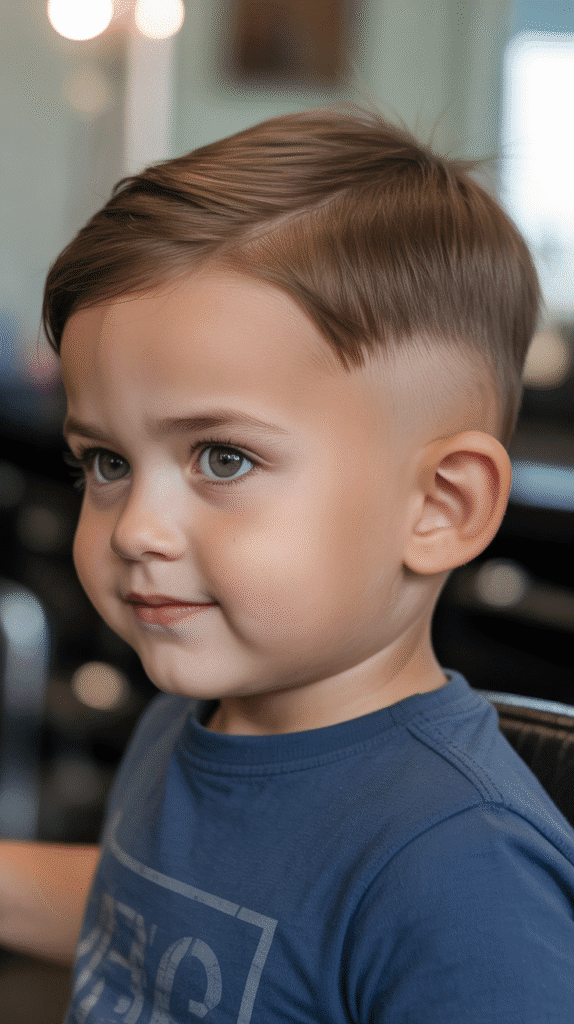
The classic low fade remains a timeless choice for toddler boys who need a haircut that’s both sophisticated and easy to manage.
This style features a gradual fade that starts just above the ears and neckline, creating a clean, polished appearance without being too dramatic for young children.
Key Features:
- The fade begins lower on the head, typically around the ears and neckline
- Creates a subtle transition that’s perfect for conservative parents or formal occasions
- Requires less frequent touch-ups compared to higher fades
- Works exceptionally well with various hair textures and face shapes
- Maintains enough length on top for simple styling options
Styling Tips:
- Use a small amount of lightweight hair product designed for children
- Comb the top section forward or to the side for a neat appearance
- The low fade grows out gracefully, extending time between haircuts
- Perfect for toddlers who don’t sit still during lengthy grooming sessions
Maintenance:
- Schedule trims every 3-4 weeks to maintain the fade’s sharpness
- Use gentle, sulfate-free shampoos to keep the scalp healthy
- The low maintenance nature makes it ideal for busy parents
2. High Fade with Textured Top

The high fade with textured top brings a modern, edgy look to your toddler’s appearance while maintaining the adorable factor.
This style features a fade that starts higher on the head, creating more contrast between the short sides and the voluminous top.
Characteristics:
- The fade begins around the temple area or higher on the sides
- Creates a bold, eye-catching contrast between short sides and longer top
- The textured top adds dimension and movement to the hairstyle
- Particularly flattering for toddlers with thick or wavy hair
- Offers a contemporary look that photographs beautifully
Styling Approach:
- Apply a small amount of texturizing product to damp hair
- Use your fingers to create natural-looking texture and separation
- Avoid heavy products that might weigh down fine toddler hair
- The textured top can be styled messy for a playful, carefree look
Best Suited For:
- Active toddlers who need hair that stays out of their face
- Boys with naturally thick or coarse hair texture
- Parents looking for a statement-making haircut
- Special occasions and photo sessions
3. Skin Fade with Quiff

The skin fade with quiff transforms your toddler into a mini fashion icon with this ultra-clean and stylish combination.
The skin fade creates the sharpest possible transition, while the quiff adds height and personality to the overall look.
Style Elements:
- The fade goes down to the skin, creating an ultra-clean appearance
- The quiff involves styling the front section upward and slightly back
- Combines classic barbering techniques with modern styling
- Creates a sophisticated look that’s surprisingly adorable on toddlers
- Requires a skilled barber experienced with children’s haircuts
Styling Instructions:
- Blow-dry the front section upward while the hair is still damp
- Use a small amount of pomade or styling cream for hold
- Brush or comb the front section up and slightly back
- Keep the quiff proportional to your toddler’s head size for balance
Considerations:
- Best for toddlers with cooperative temperaments during styling
- May require daily styling to maintain the quiff shape
- Works particularly well for special events and photographs
- The dramatic fade requires more frequent barbershop visits
4. Mid Fade with Side Part
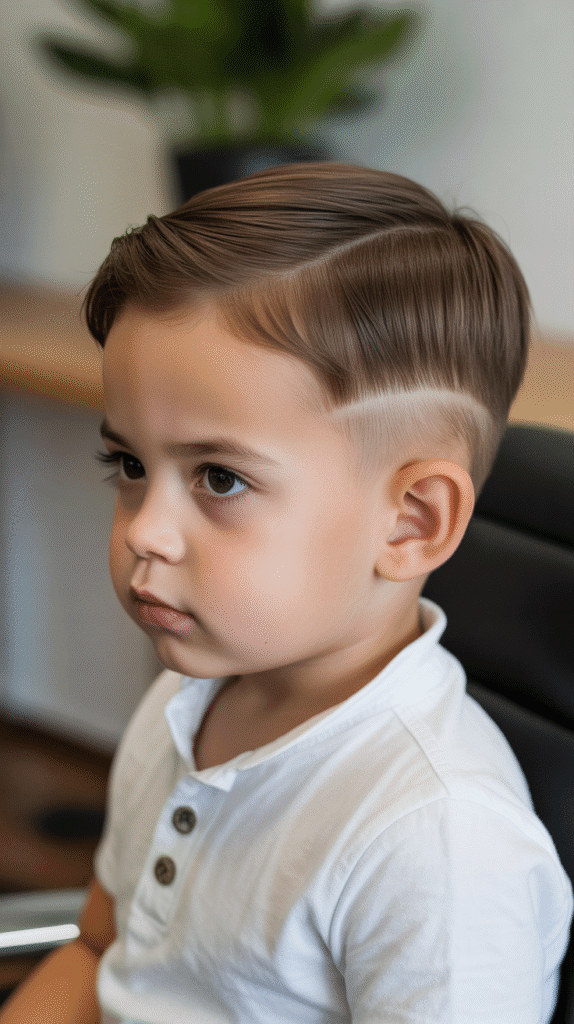
The mid fade with side part strikes the perfect balance between classic and contemporary, offering a versatile look that suits virtually any occasion.
This style positions the fade in the middle area of the head, creating a harmonious blend that’s neither too conservative nor too bold.
Defining Features:
- The fade starts midway between the low and high fade positions
- A defined side part adds structure and sophistication
- Creates a polished appearance suitable for any setting
- The mid-level positioning works with all face shapes
- Offers excellent versatility in styling options
How to Style:
- Create a distinct side part using a fine-tooth comb
- Use a lightweight styling product to keep the part in place
- Comb the top section neatly to one side
- The defined part adds a grown-up touch to the adorable toddler face
Advantages:
- Professional enough for family gatherings and formal events
- Casual enough for everyday wear and playground activities
- The side part helps keep hair out of your toddler’s eyes
- Grows out evenly and maintains shape between cuts
5. Burst Fade with Mohawk
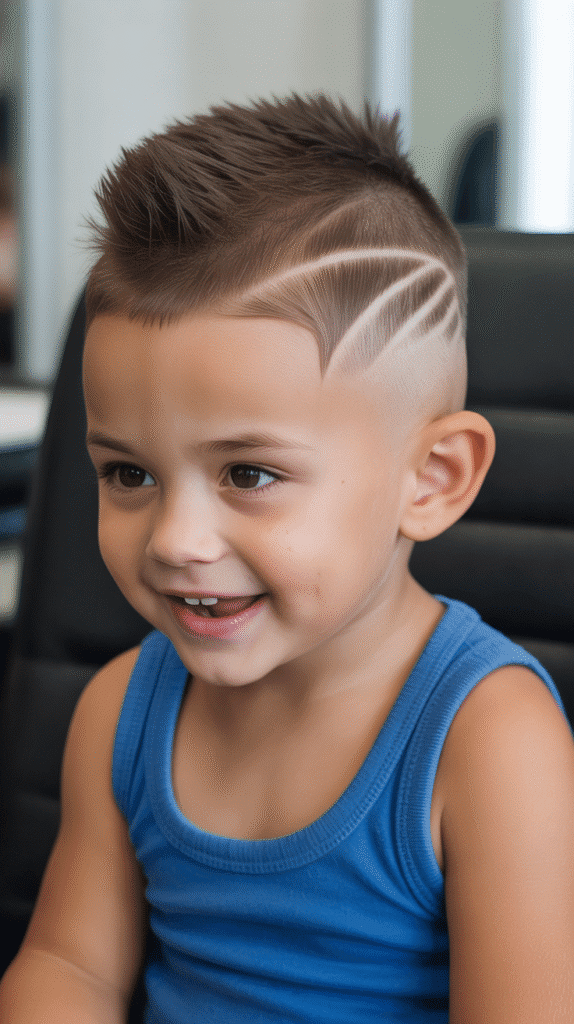
The burst fade with mohawk brings playful edge to your toddler’s look while remaining undeniably cute.
This creative style features a fade that curves around the ears, complementing a strip of longer hair running down the center of the head.
Style Characteristics:
- The fade curves in a semi-circular pattern around and behind the ears
- A mohawk strip runs from front to back with more length
- Creates a fun, rebellious look that’s still age-appropriate
- The burst pattern adds unique visual interest
- Perfect for parents who want their toddler to stand out
Styling Methods:
- The mohawk section can be styled upward for special occasions
- For everyday wear, leave it natural or brush it forward
- Use minimal product to avoid irritating sensitive toddler scalps
- The style looks adorable whether styled up or left casual
Ideal Candidates:
- Toddlers with outgoing, bold personalities
- Boys with enough hair density to create a visible mohawk strip
- Parents who appreciate creative, non-traditional hairstyles
- Children who enjoy getting compliments on their unique look
6. Temple Fade with Curls

The temple fade with curls celebrates natural texture while maintaining a clean, groomed appearance.
This style specifically targets the temple area for fading, allowing the beautiful natural curls on top to remain the focal point.
Key Attributes:
- The fade is concentrated primarily around the temple regions
- Preserves maximum length and volume for natural curls
- Creates a frame for the face while highlighting curl pattern
- Less dramatic than full fades, perfect for curl-conscious parents
- Maintains the natural beauty of textured hair
Care and Styling:
- Use curl-specific products designed for children’s hair
- Apply leave-in conditioner to keep curls defined and moisturized
- Avoid brushing dry curls, which can cause frizz
- The temple fade keeps the style neat without sacrificing curl length
Benefits:
- Celebrates and enhances natural curl patterns
- Reduces bulk on the sides while maintaining top volume
- Creates a balanced silhouette that’s proportional for toddlers
- Lower maintenance than styles requiring daily manipulation
Cultural Significance:
- Particularly popular in communities that value natural hair texture
- Represents a modern approach to embracing natural curls
- Teaches children to appreciate their natural hair from a young age
7. Drop Fade with Spiky Top

The drop fade with spiky top combines fun and functionality in one adorable package.
The drop fade creates a unique curved transition that drops down behind the ears, while the spiky top adds playful energy to the overall look.
Style Components:
- The fade drops lower as it moves toward the back of the head
- Creates an arc-like shape that follows the natural head contour
- Spikes on top add dimension and youthful energy
- The combination offers visual interest from multiple angles
- Works particularly well with medium to thick hair density
Styling Process:
- Apply a small amount of lightweight gel or mousse to towel-dried hair
- Use your fingers to lift and separate hair into small spikes
- Keep spikes soft and age-appropriate, not too stiff or extreme
- The styling process is quick, perfect for busy mornings
Practical Considerations:
- Spikes naturally relax throughout the day, which is completely fine
- The style maintains its shape even as spikes soften
- Drop fade creates a unique look that sets it apart from standard fades
- Regular trims keep the fade and proportions looking sharp
8. Taper Fade with Fringe
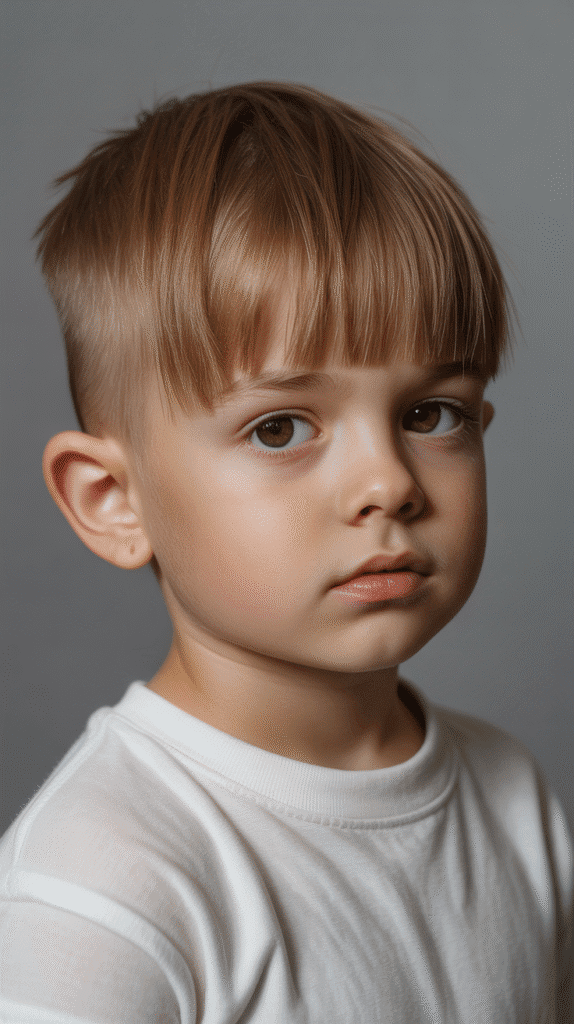
The taper fade with fringe offers a softer alternative to dramatic fades while still delivering style and sophistication.
This approach gradually tapers the hair rather than creating a stark fade, and the fringe adds a touch of European flair.
Defining Aspects:
- The taper creates a gradual decrease in length rather than a sharp fade
- The fringe falls naturally across the forehead
- Offers a gentler, less edgy appearance than traditional fades
- The soft lines are particularly flattering on round toddler faces
- Creates a timeless look that never goes out of style
Styling the Fringe:
- The fringe can be styled forward, to the side, or slightly swept
- Use minimal product to maintain a natural, touchable texture
- The fringe helps frame the face and draws attention to the eyes
- Length can be adjusted based on your toddler’s forehead size
Maintenance Requirements:
- Requires regular trims to keep the fringe at the desired length
- The taper grows out more gradually than sharp fades
- Gentle enough for first-time fade experiences
- Easy for parents to manage at home between professional cuts
9. Undercut Fade Combination

The undercut fade combination delivers maximum impact by merging two popular techniques into one stunning style.
This bold choice creates distinct layers with the undercut’s disconnect and the fade’s gradual blending.
Technical Elements:
- Features both an undercut’s sharp disconnect and fade transitions
- Creates dramatic length contrast between top and sides
- The top section maintains significant length for versatility
- Requires expert barbering skills to execute properly
- Makes a strong style statement while remaining adorable
Versatility Options:
- The longer top can be styled in multiple ways throughout the week
- Slick it back for formal occasions
- Spike it up for playful weekend looks
- Leave it natural and tousled for everyday wear
- The undercut section provides cooling relief in warm weather
Special Considerations:
- Best for toddlers who tolerate longer salon sessions
- Requires commitment to regular maintenance visits
- The dramatic contrast may not suit all environments or family preferences
- Creates stunning photos and memorable looks for special occasions
10. Bald Fade with Design
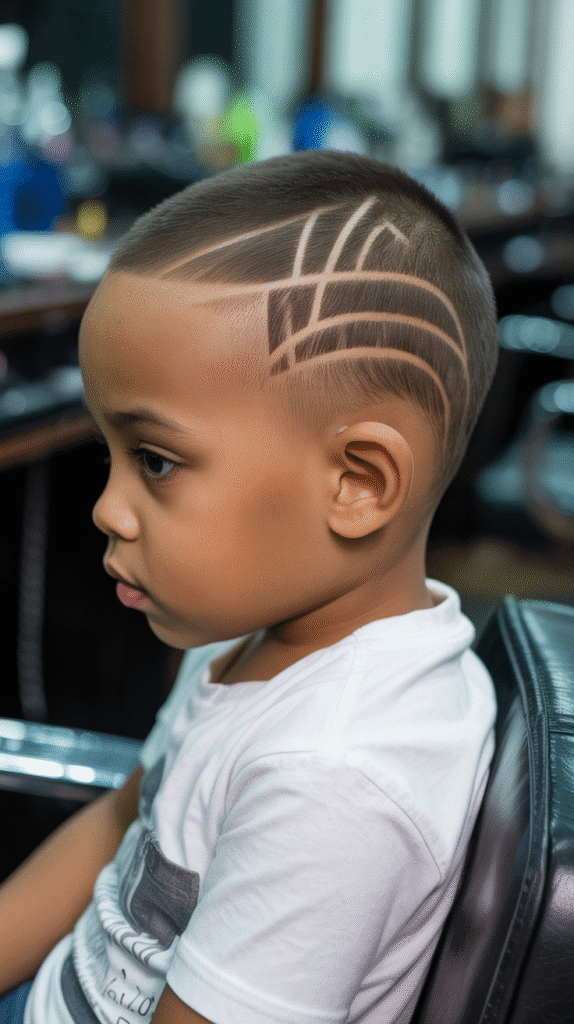
The bald fade with design takes creativity to the next level by incorporating artistic line work into the fade.
This style features the cleanest possible fade to the skin, enhanced with shaved designs that add personality and flair.
Creative Elements:
- The fade goes completely to bare skin for maximum contrast
- Line designs can include simple lines, geometric patterns, or custom artwork
- Creates a truly unique look that expresses individuality
- The designs can be changed with each haircut for variety
- Popular patterns include lightning bolts, waves, and curved lines
Design Options:
- Simple straight lines are easiest to maintain and most age-appropriate
- Curved designs add artistic flair and visual interest
- Geometric patterns create modern, trendy appearances
- Custom designs can incorporate your toddler’s interests or favorite symbols
Practical Notes:
- Designs grow out within 1-2 weeks and require frequent touch-ups
- Best for special occasions, photo shoots, or events
- Requires a skilled barber with artistic ability and steady hands
- Keep designs simple and age-appropriate for toddlers
11. Low Skin Fade with Comb Over
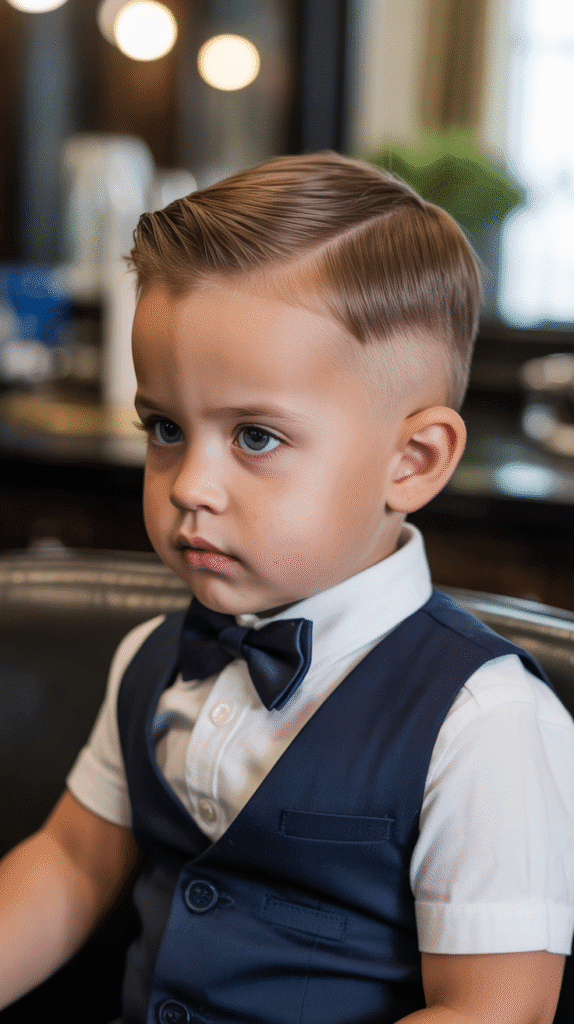
The low skin fade with comb over brings classic gentlemen’s styling into the toddler world with absolutely charming results.
This sophisticated combination pairs the clean look of a skin fade with the timeless elegance of a comb over.
Style Description:
- The skin fade starts low, just above the ears and neckline
- Hair on top is combed to one side in a classic swept style
- Creates a miniature gentleman appearance that’s undeniably cute
- The contrast between clean sides and styled top is visually striking
- Perfect for toddlers with naturally straight or slightly wavy hair
Styling Technique:
- Apply a small amount of water-based pomade to damp hair
- Use a fine-tooth comb to create a smooth comb over
- The swept style keeps hair neatly off the face
- Can be made more casual by loosening the combed texture
Occasion Suitability:
- Ideal for weddings, family portraits, and formal events
- Appropriate for religious services and special ceremonies
- Transitions well to everyday wear with less structured styling
- Teaches young boys about taking pride in their appearance
12. High Top Fade
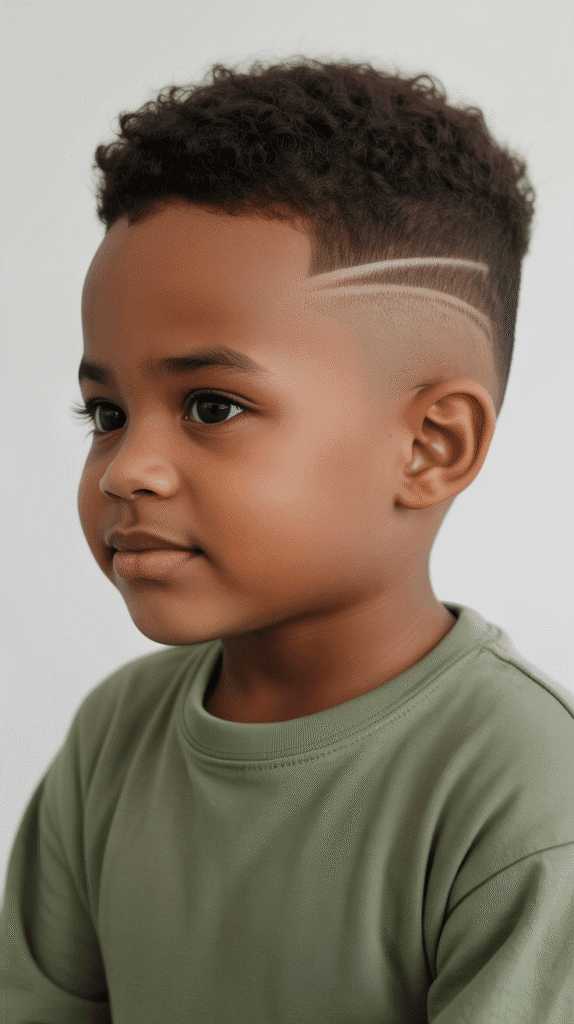
The high top fade pays homage to classic hip-hop culture while looking absolutely adorable on toddler boys.
This iconic style features a flat, elevated top section with faded sides, creating a distinctive squared-off silhouette.
Iconic Features:
- The top section is left long and shaped into a flat, box-like form
- Sides are faded short, creating dramatic height contrast
- The style creates a strong, confident appearance
- Particularly striking on toddlers with naturally thick or coarse hair
- Represents a culturally significant hairstyle with decades of history
Maintenance and Styling:
- Requires regular shaping to maintain the flat top surface
- The top section needs periodic trimming to keep the box shape
- Use a pick or wide-tooth comb to lift and shape the hair
- Moisturizing products help maintain hair health and manageability
Cultural Context:
- Originally popularized in the 1980s and 1990s
- Experiencing a modern revival among fashion-forward parents
- Celebrates natural hair texture and volume
- Creates a bold, memorable look that photographs exceptionally well
13. Shadow Fade with Textured Crop

The shadow fade with textured crop delivers subtle sophistication through its understated approach.
The shadow fade creates a gentle gradient that’s less dramatic than traditional fades, paired with a modern textured crop on top.
Style Characteristics:
- The shadow fade creates a softer, more subtle transition than standard fades
- The textured crop features short, choppy layers with natural movement
- Creates a contemporary, European-inspired aesthetic
- The muted contrast is perfect for conservative environments
- Offers low-maintenance styling that still looks intentional
Texturing Details:
- The crop is cut with point-cutting or texturizing shears
- Creates piece-y separation and natural movement
- Requires minimal to no styling product
- The texture adds visual interest without requiring daily effort
Benefits:
- Grows out gracefully without looking unkempt
- The subtle fade extends time between necessary haircuts
- Appropriate for schools with strict grooming policies
- The natural texture suits active toddlers who don’t want fussy hair
14. Faux Hawk Fade
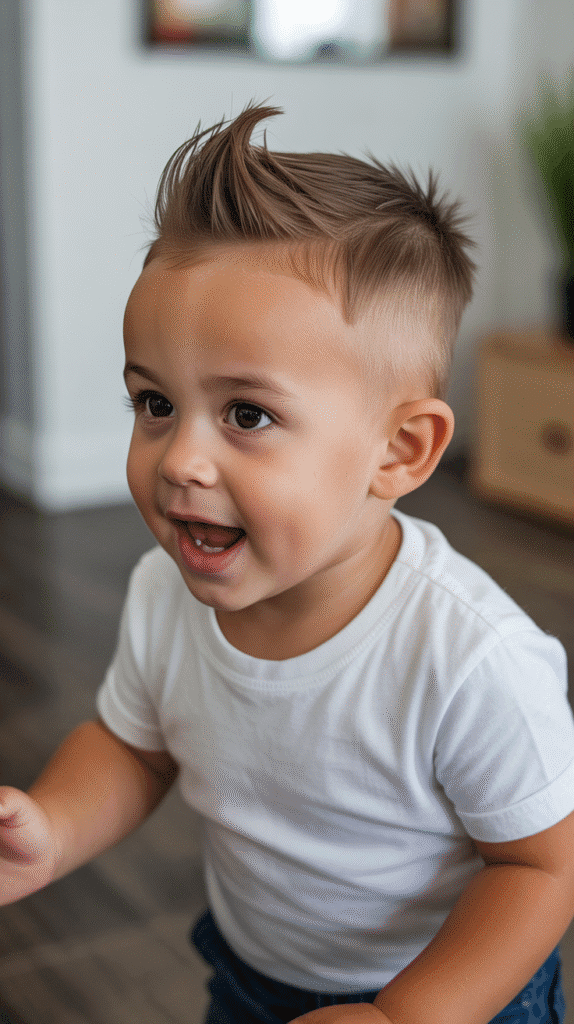
The faux hawk fade channels edgy style while remaining playful and age-appropriate for toddlers.
This popular style creates the illusion of a mohawk through strategic cutting and styling, without committing to an actual mohawk cut.
Design Elements:
- The center strip is left longer than the sides but not as extreme as a mohawk
- Faded sides create the contrast needed for the faux hawk effect
- Can be styled up for special occasions or left relaxed for everyday
- Offers the cool factor of a mohawk with more versatility
- The graduated length allows for multiple styling options
Styling Flexibility:
- Style the center section upward for maximum faux hawk effect
- Brush forward for a more casual, textured look
- Leave natural for an effortless, tousled appearance
- The style works whether actively styled or left unstyled
Personality Match:
- Perfect for energetic, confident toddlers
- Suits boys who love attention and compliments
- Appeals to parents who want trendy without being too extreme
- Creates a fun, youthful appearance that matches toddler energy levels
15. Crew Cut Fade
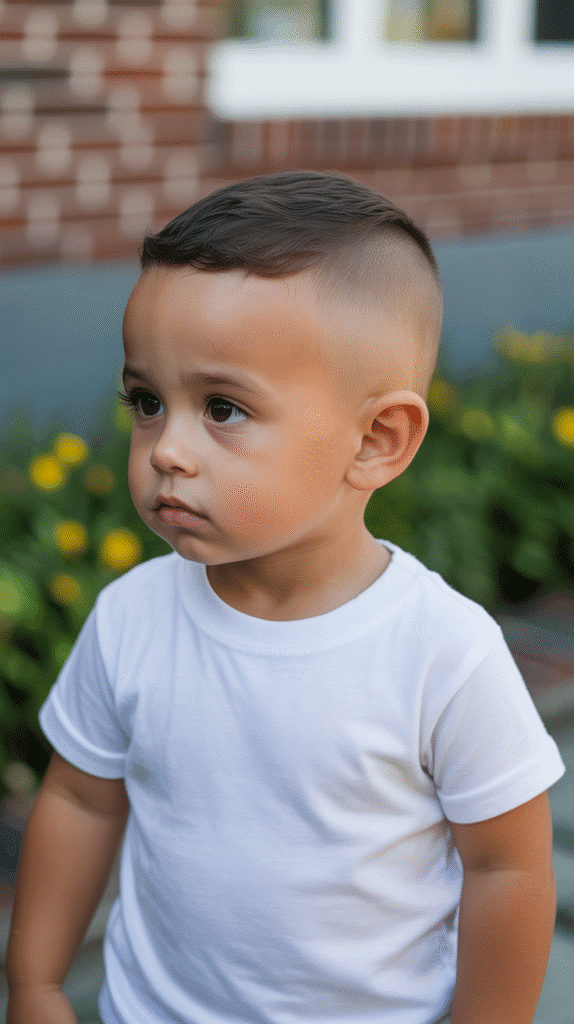
The crew cut fade combines military-inspired precision with toddler cuteness in a wonderfully practical package.
This no-nonsense style features very short hair on top that’s even shorter on the sides, creating a clean, easy-care look.
Key Characteristics:
- The top is cut short, typically 1-2 inches in length
- Sides feature a fade that transitions even shorter
- Creates an ultra-low-maintenance style perfect for active toddlers
- The military-inspired cut looks sharp and well-groomed
- Keeps hair completely off the face and out of the eyes
Practical Advantages:
- Requires virtually no daily styling or maintenance
- Perfect for summer months when shorter hair is more comfortable
- Ideal for toddlers involved in swimming or sports activities
- Grows out slowly and maintains shape well between cuts
Ideal For:
- Boys with thick, coarse hair that can look bulky when longer
- Active toddlers who hate having hair styled or touched
- Families seeking the ultimate low-maintenance haircut
- Hot climates where shorter hair is more comfortable
16. Pompadour Fade
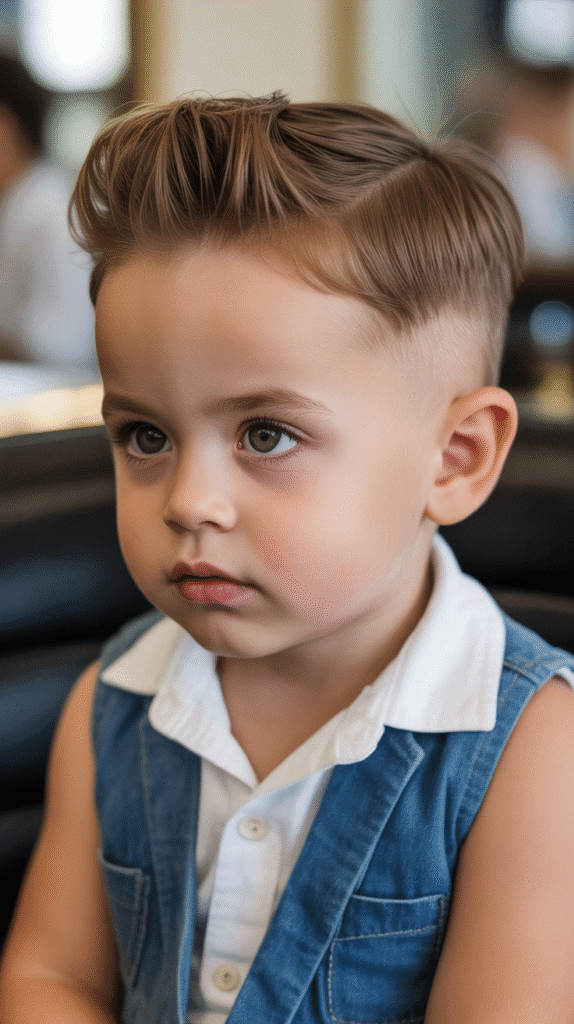
The pompadour fade transforms your toddler into a miniature rockabilly star with this voluminous, retro-inspired style.
The pompadour features hair swept upward and back from the forehead, creating height and drama that’s surprisingly adorable on little ones.
Style Elements:
- The front section is styled upward and back, creating volume and height
- Faded sides provide clean contrast to the voluminous top
- Requires enough length on top to create the pompadour shape
- The retro styling creates a timeless, classic appearance
- Works best with straight to slightly wavy hair textures
Styling Requirements:
- Blow-dry the front section upward while applying heat
- Use a round brush to create volume and shape
- Apply pomade or styling cream for hold and shine
- The styling process requires patience and cooperation
Occasions:
- Perfect for formal events, weddings, and special photographs
- Creates a memorable look for milestone celebrations
- Can be toned down for everyday wear by reducing height
- Makes a strong impression at family gatherings
17. Messy Top Fade
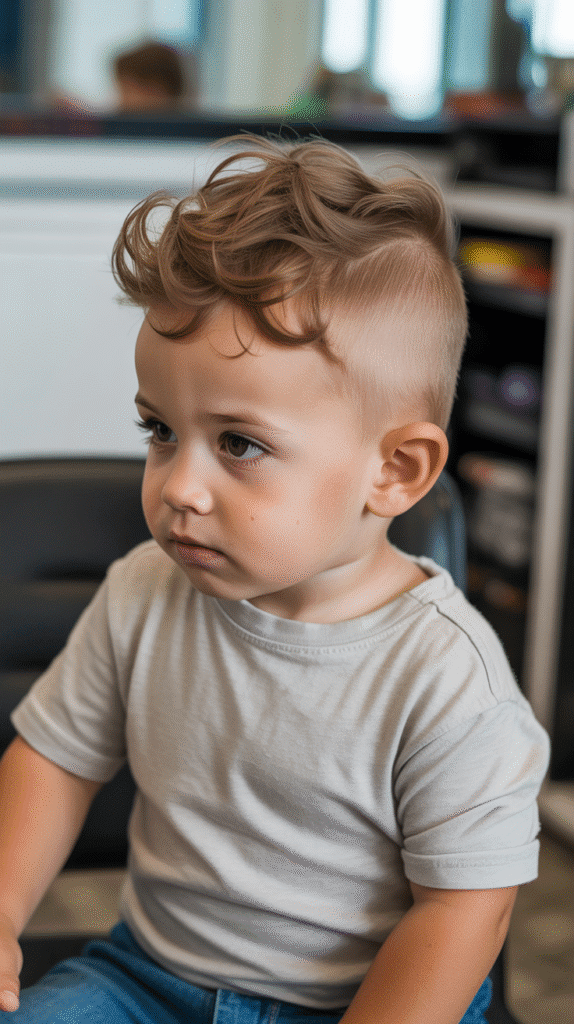
The messy top fade embraces natural texture and carefree style, perfect for toddlers who embody the “tousled and adorable” aesthetic.
This intentionally disheveled look pairs deliberately messy top styling with clean faded sides.
Style Philosophy:
- The top section is cut and styled to appear naturally messy
- Faded sides keep the overall look clean despite the messy top
- Celebrates natural texture and movement
- The “undone” look actually requires strategic cutting and minimal styling
- Creates an effortlessly cool appearance that suits toddler energy
Achieving the Look:
- Cut the top with texturizing techniques that encourage natural movement
- Use a small amount of matte product to enhance texture
- Tousle with fingers for the signature messy appearance
- The style should look natural, not forced or overdone
Benefits:
- Hides the fact that hair hasn’t been carefully styled
- Perfect for busy mornings when time is limited
- Suits active toddlers whose hair gets messed up during play anyway
- The casual aesthetic is currently very trendy and fashionable
18. Curly Top with Taper Fade
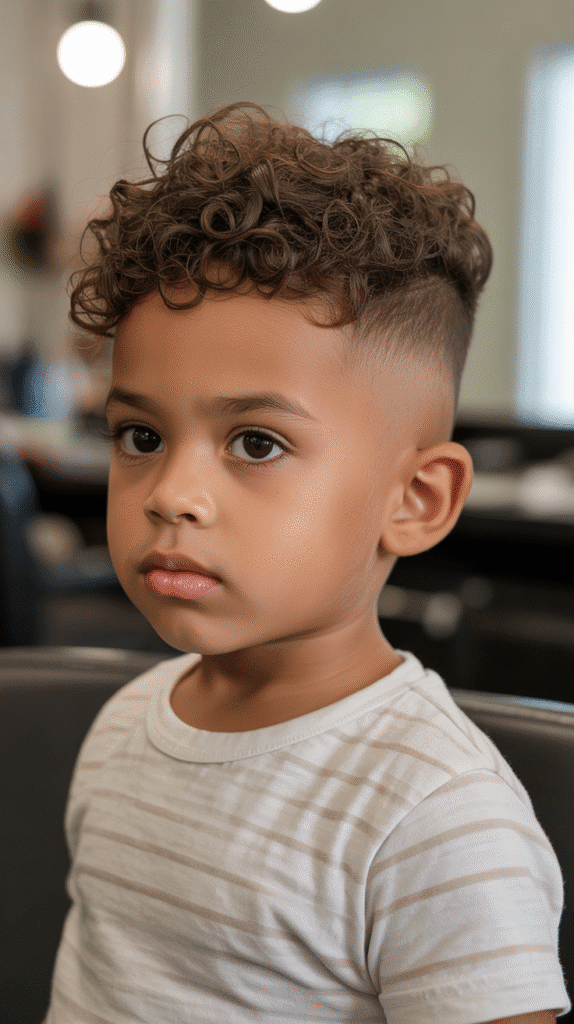
The curly top with taper fade is a celebration of natural curl beauty enhanced by clean, tapered sides.
This style preserves and showcases gorgeous natural curls while maintaining a groomed, intentional appearance through the taper.
Curl-Friendly Features:
- Maximum length is preserved on top to showcase curl pattern
- The taper gradually shortens sides without harsh fade lines
- Creates a proportional silhouette that balances curl volume
- Enhances natural curl definition and bounce
- The gentler taper is less maintenance than sharp fades
Curl Care:
- Use sulfate-free, curl-specific shampoos and conditioners
- Apply leave-in products to maintain curl definition and moisture
- Never brush dry curls; use fingers or a wide-tooth comb on wet hair
- The taper reduces bulk while preserving curl integrity
Styling Approach:
- Work with natural curl pattern rather than fighting it
- Apply curl cream or gel to wet hair and allow to air dry
- Refresh curls between washes with water and light product
- Embrace the natural volume and texture curls provide
19. Line Up with Low Fade
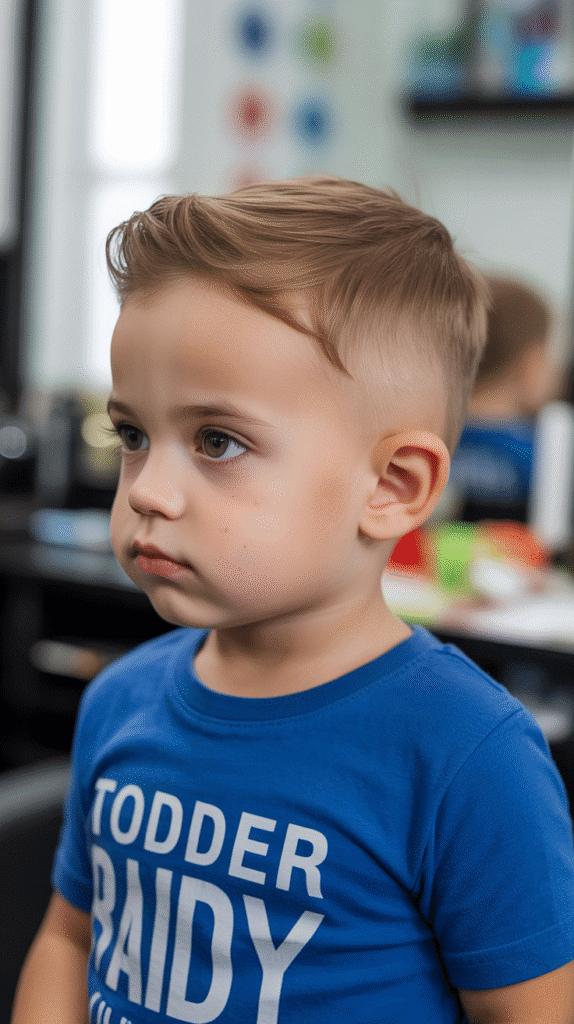
The line up with low fade delivers precision and clean lines that create an ultra-sharp, well-groomed appearance.
This style features defined edges around the hairline combined with a subtle low fade, resulting in a polished, sophisticated look.
Precision Elements:
- The hairline is shaped with clippers to create sharp, defined edges
- Straight lines are created at the temples and across the forehead
- The low fade complements the sharp lines with gradual tapering
- Creates a frame for the face that enhances facial features
- The geometric precision looks striking and intentional
Technical Execution:
- Requires a skilled barber with steady hands and attention to detail
- The line up defines the natural hairline or creates a new shape
- Sharp angles at the temples create a crisp, clean appearance
- Regular maintenance is essential to keep lines sharp
Maintenance Considerations:
- Lines grow out within 1-2 weeks and may need touch-ups
- Some parents learn to maintain edges at home between cuts
- The precision requires commitment to regular barbershop visits
- Best for toddlers who can sit relatively still during detailed work
20. Brush Up Fade
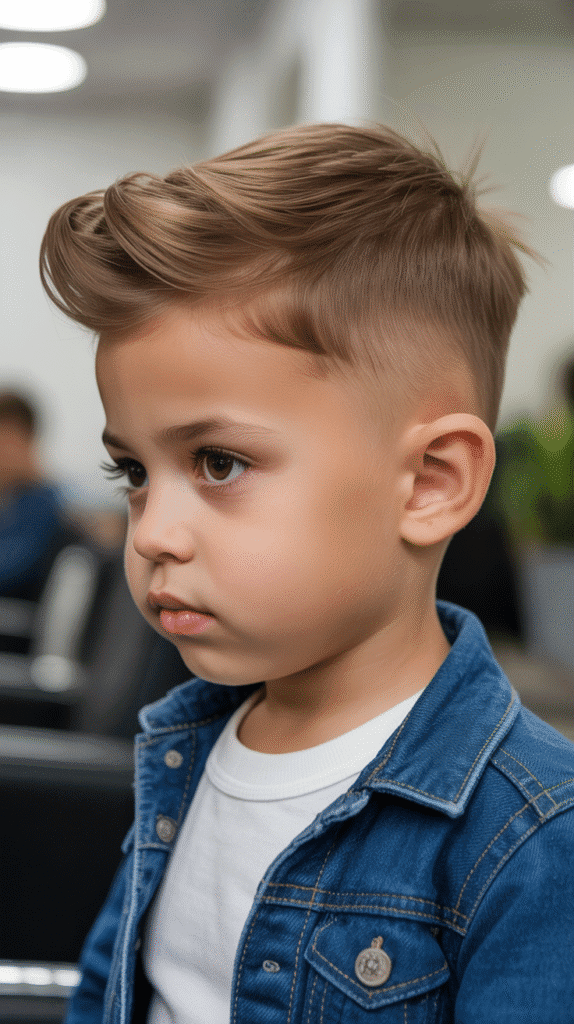
The brush up fade creates vertical volume and modern style by directing all hair upward and forward.
This contemporary look combines textured, upward-styled hair with clean faded sides for a trendy, fashion-forward appearance.
Style Mechanics:
- Hair on top is styled vertically upward from the scalp
- Creates height and volume that’s visually striking
- The brushed-up texture adds dimension and movement
- Faded sides provide clean contrast to the voluminous top
- Works particularly well with medium-length hair
Styling Process:
- Apply volumizing product to damp hair
- Use a blow dryer and brush to direct hair upward
- Finish with a light-hold product to maintain the upward direction
- The style should look textured and natural, not stiff
Contemporary Appeal:
- Currently trending among fashion-conscious parents
- Creates a modern, editorial look that photographs beautifully
- Suits confident toddlers who enjoy standing out
- The vertical emphasis adds visual height
21. Caesar Cut Fade
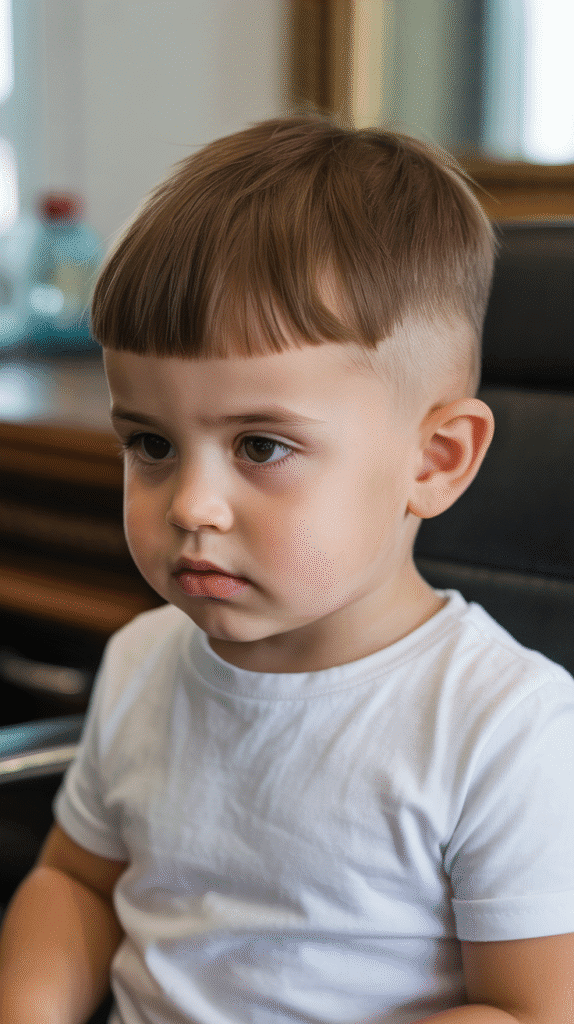
The Caesar cut fade brings ancient Roman style into the modern era with this short, forward-brushed cut enhanced by contemporary fade techniques.
Named after Julius Caesar, this timeless style features a short, horizontally cut fringe with faded sides.
Historical Style Updated:
- The top is cut short with a horizontal fringe across the forehead
- Hair is brushed forward rather than up or to the side
- Faded sides modernize this ancient Roman-inspired cut
- Creates a neat, low-maintenance style with historical significance
- The short length is practical while remaining stylish
Styling Simplicity:
- Simply brush or comb the hair forward after washing
- Requires minimal to no styling product
- The short length makes morning routines quick and easy
- Maintains shape throughout the day with minimal fussing
Ideal Candidates:
- Toddlers with fine or thin hair that looks better shorter
- Boys who dislike having hair in their faces
- Parents seeking a historically-inspired yet modern style
- Those who prioritize practicality without sacrificing style
22. Wavy Top with Mid Fade
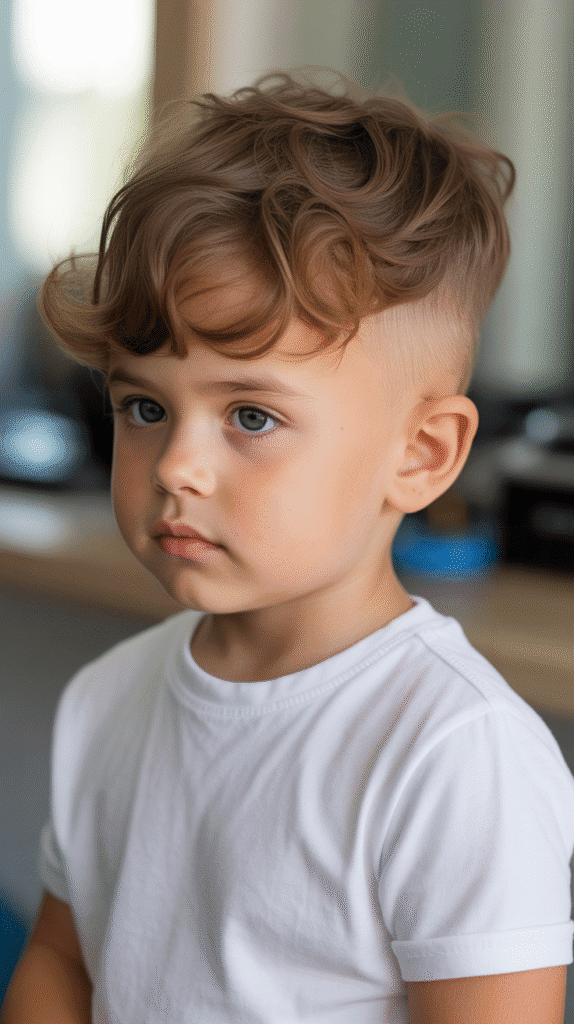
The wavy top with mid fade celebrates natural wave patterns while maintaining structure through the mid-level fade.
This style works harmoniously with hair’s natural texture, enhancing waves rather than fighting them.
Wave-Enhancing Features:
- Preserves length on top to allow waves to form naturally
- The mid fade balances the volume created by natural waves
- Creates movement and flow that’s visually appealing
- Enhances natural texture rather than requiring extensive styling
- The waves add softness to the overall appearance
Working With Waves:
- Use wave-enhancing products like sea salt spray or curl cream
- Apply product to damp hair and scrunch gently
- Allow hair to air dry or use a diffuser on low heat
- Avoid brushing dry waves, which can cause frizz
Texture Benefits:
- Natural waves add dimension and visual interest
- The texture requires minimal daily styling effort
- Waves hide minor imperfections and cowlicks
- Creates a beachy, relaxed aesthetic that’s currently popular
23. Blowout Fade
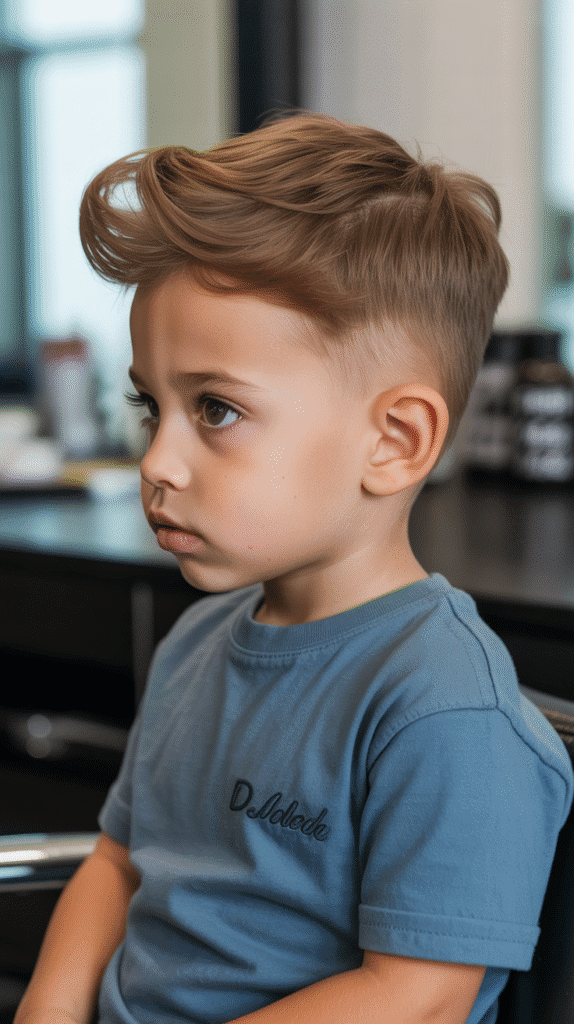
The blowout fade creates maximum volume and drama through professional blow-drying techniques combined with expertly faded sides.
This style pushes hair upward and outward, creating a voluminous, attention-grabbing appearance that’s surprisingly cute on toddlers.
Volume Characteristics:
- Hair is blown outward from the scalp, creating significant volume
- The blowout effect adds height and fullness throughout the top
- Faded sides provide clean contrast to the voluminous crown
- Creates a bold, statement-making appearance
- Works best with thick, coarse hair that holds volume well
Achieving the Blowout:
- Professional blow-drying with round brushes creates the foundation
- Volumizing products are essential for creating and holding lift
- The technique requires skill and the right tools
- Hair should look full and textured, not stiff or sprayed
Maintenance Reality:
- The blowout effect gradually relaxes throughout the day
- May require professional styling for special events
- Daily recreation at home can be time-consuming
- Best reserved for occasions when maximum impact is desired
Style Impact:
- Creates an unforgettable, bold appearance
- Perfect for fashion shoots, special celebrations, and formal events
- The dramatic volume makes a strong style statement
- Particularly popular in communities that value bold, expressive styling
Tips for Maintaining Your Toddler’s Fade Haircut
Keeping your toddler’s fade looking fresh requires consistent care and attention between barbershop visits.
Between-Cut Care:
- Schedule regular barbershop appointments every 2-4 weeks depending on fade type
- Sharp fades like skin fades require more frequent maintenance
- Lower, softer fades can extend longer between professional trims
- Consider learning basic touch-up techniques for edges and lines
Daily Hair Care:
- Use gentle, sulfate-free shampoos designed for children
- Avoid over-washing, which can dry out the scalp and hair
- Apply leave-in conditioner for textured or curly hair types
- Protect hair during sleep with a silk or satin pillowcase
Product Recommendations:
- Choose lightweight, water-based products specifically formulated for children
- Avoid heavy waxes or pomades that can weigh down fine toddler hair
- Test products on a small area first to check for skin sensitivity
- Store products out of reach to prevent unsupervised use
At-Home Maintenance:
- Invest in quality clippers for minor touch-ups if comfortable
- Learn to maintain edge-ups and clean neck lines between cuts
- Keep a spray bottle handy for quick restyling throughout the day
- Take reference photos of the fresh cut to show your barber
Choosing the Right Fade for Your Toddler
Selecting the perfect fade involves considering multiple factors beyond just appearance preferences.
Hair Texture Considerations:
- Fine, thin hair works best with lower, more subtle fades
- Thick, coarse hair can handle dramatic high fades and bold styles
- Curly hair benefits from fades that preserve top length
- Straight hair offers the most versatility across fade types
Face Shape Matching:
- Round faces benefit from fades with height on top to elongate
- Oval faces work well with virtually any fade style
- Square faces are complemented by softer, less angular fades
- Heart-shaped faces look great with mid-level fades
Lifestyle Factors:
- Active toddlers in sports may prefer ultra-short, low-maintenance styles
- Children in formal environments might need more conservative fades
- Hot climates call for shorter, cooler cuts
- Swimming frequency should influence length and style choices
Temperament and Cooperation:
- Toddlers who dislike grooming need quick, simple styles
- Patient children can handle more complex, styled looks
- Consider your child’s attention span during haircut sessions
- Choose styles that match their personality and energy level
Styling Products Safe for Toddlers
Using age-appropriate products ensures both style success and safety for your little one’s sensitive scalp.
**Product Safety Guidelines:**
- Always choose products specifically labeled as safe for children
- Avoid products containing harsh chemicals, sulfates, or parabens
- Check ingredient lists for potential allergens or irritants
- Perform patch tests before applying new products to the entire scalp
- Consult with your pediatrician if your toddler has sensitive skin or allergies
Recommended Product Types:
- Water-based pomades that wash out easily without residue
- Lightweight styling creams with natural ingredients
- Gentle hold gels formulated without alcohol
- Natural oils like coconut or argan for moisture and shine
- Leave-in conditioners for textured or curly hair
Application Best Practices:
- Use products sparingly—a pea-sized amount is usually sufficient
- Apply to damp rather than soaking wet or completely dry hair
- Distribute evenly using fingers or a wide-tooth comb
- Avoid applying product directly to the scalp to prevent buildup
- Wash hands thoroughly after application
Natural Alternatives:
- Aloe vera gel provides light hold without chemicals
- Coconut oil adds moisture and natural shine
- Shea butter works well for curly and coily textures
- Apple cider vinegar rinses maintain scalp health
- Simple water sprays refresh styles throughout the day
Storage and Usage:
- Keep all styling products securely stored away from children’s reach
- Check expiration dates regularly and discard old products
- Ensure containers are properly sealed to maintain product quality
- Create a designated grooming area to organize products safely
Finding the Right Barber for Your Toddler
Selecting a skilled barber who specializes in children’s haircuts makes all the difference in achieving great results and positive experiences.
What to Look For:
- Experience specifically cutting children’s hair, not just adults
- Patience and a gentle demeanor when working with young children
- A portfolio showing various fade styles on toddler-aged clients
- Clean, child-friendly barbershop environment with appropriate seating
- Positive reviews from other parents of young children
Questions to Ask:
- How long have you been cutting children’s hair specifically?
- What techniques do you use to keep toddlers calm and cooperative?
- How familiar are you with the specific fade style we want?
- What products do you recommend for maintaining the style at home?
- How often should we schedule appointments to maintain the fade?
Creating Positive Experiences:
- Schedule appointments during your toddler’s best time of day
- Avoid booking during typical nap times or when they’re likely to be hungry
- Bring distractions like favorite toys, tablets, or snacks
- Consider scheduling a consultation visit before the actual haircut
- Praise your child throughout the process to build positive associations
Building a Relationship:
- Consistency with the same barber builds trust and familiarity
- Regular appointments help your toddler become comfortable with the process
- A familiar barber learns your child’s preferences and temperament
- Long-term relationships often result in better communication and results
Red Flags:
- Barbers who seem impatient or frustrated with young children
- Shops that don’t maintain proper cleanliness and sanitation
- Professionals who refuse to show examples of their work
- Anyone who dismisses your concerns or preferences
- Environments that feel overwhelming or scary for small children
Age-Appropriate Fade Considerations
While fades look adorable on toddlers, it’s important to ensure the style is developmentally appropriate and practical.
Developmental Factors:
- Toddlers’ fine motor skills are still developing, affecting their ability to sit still
- Attention spans are limited, so simpler cuts may be more practical
- Some children are sensitive to the sounds and sensations of clippers
- Head shape and proportion continue developing, affecting style suitability
Starting Age for Fades:
- Most barbers recommend waiting until at least 18-24 months for first fades
- Earlier cuts can be simple trims to get toddlers accustomed to the process
- By age 2-3, most children can tolerate the full fade haircut experience
- Individual readiness varies based on temperament and previous haircut experiences
Safety Considerations:
- Ensure your toddler can sit relatively still for safety during clipper use
- Sharp fades require precision work near sensitive areas
- Skin fades involve blades very close to the scalp
- Consider starting with gentler taper fades before progressing to skin fades
Appropriateness Guidelines:
- Keep styles age-appropriate rather than too mature or adult-looking
- Avoid overly complex designs that require excessive maintenance
- Consider your family’s lifestyle and cultural context
- Ensure the style allows your toddler to still look and feel like a child
- Balance trendiness with timelessness for longer-lasting appeal
Common Mistakes to Avoid
Learning from common fade haircut pitfalls helps ensure better results and happier experiences for both parent and child.
Styling Mistakes:
- Using too much product, which weighs down hair and looks greasy
- Applying adult-strength products on sensitive toddler scalps
- Over-styling hair that looks better with a natural, tousled appearance
- Trying to replicate complex styles without proper tools or skills
- Fighting against natural hair texture instead of working with it
Maintenance Errors:
- Waiting too long between appointments, allowing fades to grow out completely
- Using harsh shampoos that strip natural oils and dry out hair
- Over-washing hair, which can irritate scalp and damage hair quality
- Neglecting to moisturize textured or curly hair between washes
- Skipping regular trims for the top section while maintaining the fade
Barber Selection Issues:
- Choosing a barber based solely on price rather than skill with children
- Not communicating clearly about desired style and expectations
- Failing to bring reference photos showing exactly what you want
- Booking appointments at inconvenient times when toddlers are cranky
- Not preparing your child for what to expect during the haircut
Unrealistic Expectations:
- Expecting toddler hair to hold styles the same way adult hair does
- Choosing styles that require cooperation beyond your child’s developmental level
- Comparing your child’s results to heavily styled or edited social media photos
- Assuming the first attempt will be perfect without trial and adjustment
- Forgetting that hair grows and changes texture as children develop
Fade Haircuts for Different Hair Types
Understanding how different hair types respond to fade cuts ensures better style choices and results.
Straight Hair:
- Holds crisp lines and defined shapes exceptionally well
- Shows fade transitions very clearly due to uniform texture
- Requires less product to maintain styled looks
- Can appear too severe if fades are too sharp or high
- Works well with virtually all fade variations and styling options
Wavy Hair:
- Adds natural texture and movement to fade styles
- Softens harsh fade lines for a more forgiving appearance
- May require wave-enhancing products for definition
- The natural texture reduces need for extensive styling
- Works beautifully with messy, textured top styles
Curly Hair:
- Creates dramatic volume contrast with faded sides
- Requires moisture-focused care to maintain curl health
- Fade placement is crucial to avoid top-heavy appearance
- Natural curl pattern should be celebrated, not fought against
- Temple fades and low fades often work best to preserve curl length
Coily/Kinky Hair:
- Benefits from fades that reduce bulk while celebrating texture
- Requires specialized cutting techniques and experienced barbers
- Moisture is absolutely essential for maintaining hair health
- Natural texture adds unique dimension to fade styles
- Cultural context and hair care traditions should inform style choices
Fine/Thin Hair:
- Lower, more subtle fades work best to avoid looking too sparse
- Texturizing techniques add the appearance of more volume
- Lightweight products prevent weighing down delicate hair
- Avoid dramatic high fades that can emphasize thinness
- Styles with textured tops create the illusion of fuller hair
Thick/Coarse Hair:
- Can handle dramatic high fades and bold style statements
- Regular thinning may be needed to reduce bulk
- Holds shape well with minimal product
- Allows for more creative and complex fade designs
- Works well with structured styles like pompadours and quiffs
Seasonal Fade Considerations
Different seasons call for different approaches to your toddler’s fade haircut maintenance and styling.
Summer Styles:
- Shorter fades and cuts provide cooling relief during hot months
- Crew cuts and buzz cuts paired with fades maximize comfort
- Higher fades reduce bulk and heat retention
- UV protection for scalp becomes important with shorter styles
- Chlorine from swimming pools requires special hair care attention
- More frequent haircuts may be needed as hair grows faster in summer
Fall Adaptations:
- Slightly longer lengths on top provide more versatility
- Transitional styles that work for both warm and cool days
- Back-to-school cuts should consider dress code requirements
- Growth planning if you want longer styles for winter
- Adjusting maintenance schedules as routines change with school
Winter Considerations:
- Longer lengths on top provide some warmth for the head
- Static electricity from winter hats requires anti-static products
- Dry indoor heating can affect scalp and hair health
- Moisturizing becomes more important to prevent dryness
- Hat head requires styles that can be easily refreshed
- Consider slightly lower fades to provide more coverage
Spring Refresh:
- Perfect time to try new styles as weather improves
- Gradually shorter cuts in preparation for summer heat
- Fresh starts align with spring’s renewal energy
- Addressing any winter damage from dry air and hats
- Planning ahead for summer activities and comfort needs
Cultural Considerations for Fade Haircuts
Fade haircuts carry cultural significance and history that should be acknowledged and respected.
Historical Context:
- Fade haircuts have deep roots in African American barbering traditions
- The style represents decades of cultural expression and identity
- Military influence contributed to fade popularity across communities
- Understanding this history shows respect for the style’s origins
- Appreciation rather than appropriation should guide style choices
Cultural Significance:
- In many communities, barbershops serve as important cultural spaces
- The fade haircut represents pride, self-care, and cultural identity
- Certain fade styles carry specific cultural meanings and associations
- Supporting culturally authentic barbers preserves traditional techniques
- Teaching children about their hairstyle’s cultural context builds pride
Respectful Approach:
- Acknowledge the cultural origins when discussing or choosing fades
- Support barbers from the communities where these styles originated
- Avoid treating cultural hairstyles as mere trends or fashion statements
- Educate yourself about the history and significance of chosen styles
- Teach your children to appreciate diversity in hair culture
Global Variations:
- Different cultures have unique fade variations and barbering traditions
- Latin American barbering culture contributes distinct fade techniques
- Asian barbering brings different approaches to fade cutting and styling
- European influences add their own interpretations to classic fades
- Recognizing global contributions enriches understanding and appreciation
Cost Considerations for Toddler Fades
Understanding the financial aspects of maintaining fade haircuts helps with budgeting and planning.
Initial Haircut Costs:
- Children’s fade haircuts typically range from $15 to $50 depending on location
- Specialized children’s salons may charge premium prices
- Experienced barbers with excellent reputations often cost more
- Urban areas generally have higher pricing than rural locations
- Complex styles with designs or multiple fade levels may cost extra
Maintenance Expenses:
- Regular appointments every 2-4 weeks add up over time
- Annual costs can range from $200 to $800 depending on frequency
- Skin fades and sharp styles require more frequent, costly maintenance
- Lower fades and tapers are more economical long-term options
- Factor in tips for barbers who provide excellent service
Product Costs:
- Initial investment in quality children’s styling products ($20-50)
- Monthly product replenishment averages $10-20 for most families
- Natural and organic options may cost more but offer safer ingredients
- Buying larger sizes or sets can provide cost savings
- Minimal product use with toddlers means supplies last longer
Cost-Saving Strategies:
- Learning basic maintenance skills reduces professional visit frequency
- Investing in quality clippers for home touch-ups ($30-100 one-time cost)
- Choosing lower-maintenance fade styles reduces overall expenses
- Building relationships with barbers may result in loyalty discounts
- Scheduling appointments during non-peak times sometimes costs less
Value Considerations:
- Quality cuts from skilled barbers last longer and look better
- Cheap cuts often require more frequent corrections and fixes
- The confidence boost from a great haircut has intangible value
- Positive barbershop experiences contribute to your child’s development
- Investing in your child’s appearance supports their self-esteem
Troubleshooting Common Fade Issues
Even the best fade haircuts can encounter problems that need addressing.
Uneven Fade Lines:
- May result from natural head shape irregularities
- Can be corrected by experienced barbers with blending techniques
- Sometimes requires waiting for growth before fixing
- Communicate concerns immediately so barber can address them
- Take photos to show barber exactly where unevenness appears
Fade Growing Out Poorly:
- Lower fades generally grow out more gracefully than high fades
- Regular maintenance prevents awkward in-between stages
- Some touch-up work can extend time between full cuts
- Hats and styling can disguise growth during transition periods
- Planning haircut timing around special events prevents poor-timing issues
Scalp Irritation:
- May indicate allergic reaction to products or sensitivity to clippers
- Switch to hypoallergenic, fragrance-free products
- Ensure barber uses clean, sanitized tools
- Apply soothing aloe vera or gentle moisturizer to irritated areas
- Consult pediatrician if irritation persists or worsens
Style Not Holding:
- Fine or thin hair may need different products or techniques
- Over-washing removes natural oils that help hold styles
- Climate humidity affects styling product performance
- May need to adjust product type, amount, or application method
- Some styles simply don’t work with certain hair textures
Child Resisting Haircuts:
- Build positive associations through preparation and rewards
- Consider child-friendly barbershops with special seating and distractions
- Break the process into smaller sessions if necessary
- Never force a haircut if child is extremely distressed
- Work with child’s temperament rather than against it
Photo Guide: Before Your Barbershop Visit
Bringing visual references ensures clear communication and better results.
Collecting Reference Images:
- Save 3-5 photos showing different angles of desired style
- Include front, side, and back views when possible
- Choose photos of children similar in age to your toddler
- Avoid heavily edited or filtered images that misrepresent results
- Select realistic examples rather than celebrity or professional photos
What to Show Your Barber:
- Specific fade placement and how high or low it should start
- Desired length on top and how it should be styled
- Any special details like parts, designs, or texture
- Examples of what you don’t want to help clarify expectations
- Photos of previous successful cuts if returning to same barber
Taking Documentation Photos:
- Photograph your toddler’s fresh cut from all angles immediately
- These become reference photos for maintaining consistency
- Document what you liked and didn’t like about each cut
- Track your child’s hair growth patterns between cuts
- Build a visual history showing style evolution over time
Digital Organization:
- Create a dedicated folder on your phone for haircut inspiration
- Organize by style type for easy reference during consultations
- Include notes about what worked well or didn’t
- Save your barber’s contact information with the photos
- Update regularly as preferences and trends change
Conclusion
Finding the perfect haircut for your active, adorable toddler doesn’t have to be overwhelming when you explore these 23 Toddler Boy Fade Haircuts That Are Totally Adorable.
From classic low fades that offer timeless sophistication to bold high fades that make a modern statement, each style brings its own unique charm while meeting the practical needs of busy parents and energetic little boys.
The key to success lies in understanding your child’s hair texture, face shape, and personality while choosing a style that balances trendiness with age-appropriate cuteness and manageable maintenance.
Whether you opt for a subtle taper fade, a dramatic skin fade with designs, or a textured crop with a shadow fade, these versatile styles ensure your toddler looks sharp, feels comfortable, and radiates confidence.
Remember that the best fade haircut is one that makes your little one smile when they see their reflection, withstands hours of playground adventures, and brings joy to both parent and child during the grooming process.
With the right barber, appropriate products, and realistic expectations, any of these adorable fade styles can transform your toddler into the best-dressed kid on the block while creating precious memories and positive self-image that will last far beyond the toddler years.
